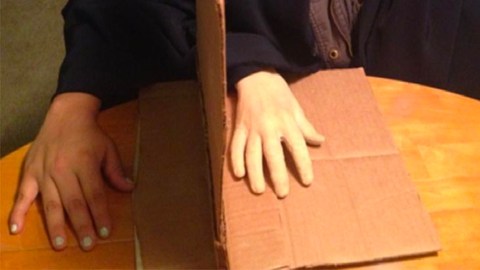How a rubber hand could treat OCD

- It is easy to trick your brain into believing that a rubber hand belongs to your body.
- OCD is a crippling condition afflicting 1 in 50 people.
- The “rubber hand illusion” could offer a novel strategy to treat this condition.
I feel anchored “here and now” in my body. But this sense of embodiment which we take for granted is an illusion created by the brain. In fact, in just five minutes, I can make you feel like a rubber hand is yours!
I simply ask you to place both your hands flat on a table in between a piece of cardboard serving as a “little wall.” You can’t see your real right hand. And left to the “cardboard screen” you see a rubber hand, which looks like your own. Now, when you look down on the table you see two hands in front of you. But only one is yours — that is, the left one. Sitting across from you, I stroke the fake hand and the hidden right hand in perfect synchrony with a paintbrush. Astonishingly, after just a few minutes you’ll most likely feel touch sensations arising from the rubber hand as if it were yours!
This compelling illusion illustrates the fragility of the sense of self and how your brain creates this feeling based on statistical correlations. It’s extremely unlikely for such stroking seen on the rubber hand and felt on the hidden real right hand to occur by random chance. So, your brain concludes, however illogical, that the rubber hand is yours. This famous psychology trick — the “rubber hand illusion” — has been known for decades, but no one had examined how it could be used to treat obsessive-compulsive disorder (OCD) until my colleagues and I hit upon a novel technique: “multisensory stimulation therapy.”
Treating OCD with a rubber hand
OCD is a crippling condition afflicting 1 in 50 people. A common type of OCD involves repetitive handwashing sometimes for hours until they bleed. These patients are petrified of trivial things like touching a garbage bin. Unsurprisingly, OCD patients suffer immensely. Yet there are few treatment options for them.
The most widely used “talking therapy” — dubbed “exposure and response prevention” — entails instructing patients to touch things they consider “disgusting” like a toilet seat and not washing their hands afterward. The aim is to make them feel anxious initially but then showing that nothing horrible occurs when they refrain from handwashing. However, a substantial limitation of this therapy is that patients fear touching things they consider contaminated. As many as 25 percent of patients outright refuse this treatment and 20 percent drop out before completion. But what if a rubber hand were to touch the disgusting objects instead — I thought to myself — one that feels like the patient’s hand? Then one could create a less fear-provoking yet realistic therapy for OCD.
To show if this could work, V.S. Ramachandran, D. Krishnakumar, and I explored if healthy volunteers (without OCD) would experience disgust if we were to contaminate the fake hand during the aforementioned rubber hand illusion. So, we first induced the illusion, and after a few minutes, we put disgusting things like fake feces on the rubber hand. Curiously, participants experienced disgust, as if the sensation was emanating from the fake hand. In other words, when they felt like the fake hand was theirs, they were grossed out by what it was touching. These findings were later replicated in a large study from Japan, suggesting that these results are reliable even across cultures.
Therefore, my colleagues at Harvard and I (in collaboration with McLean Hospital and V.S. Ramachandran) later tested this trick in OCD patients and found the same result: that is, after stroking the rubber hand for 10 minutes, OCD patients displayed disgust reactions, just as if their real hand had been contaminated.
These results are striking because they show that OCD patients can experience contamination feelings, even from a rubber hand. Such contamination feelings are, as noted above, the basis for treating OCD. Over time, by repeating this rubber hand trick, patients should build up disgust tolerance — just like standard OCD therapy — and this could therefore represent a new way of treating the disorder that keeps so many souls hostage.
OCD is a strange disorder that blurs the boundary between mind and body, reality and illusion. It may just be that one has to trick the brain to tackle OCD, combating one illusion with another.
Dr. Baland S. Jalal is a researcher at Harvard University, Department of Psychology and visiting researcher at Cambridge University, Department of Psychiatry. He obtained his PhD at Cambridge University in the School of Clinical Medicine (Trinity College Cambridge) and was a Fellow at Harvard University (2016, 2018). He is a close collaborator and co-author on ten papers with the renowned neuroscientist V.S. Ramachandran (2011 TIME magazine 100 most influential people in the world).





